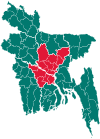Kuliarchar
কুলিয়ারচর | |
|---|---|
 | |
| Coordinates: 24°9.3′N 90°54′E / 24.1550°N 90.900°E | |
| Country | |
| Division | Dhaka |
| District | Kishoreganj |
| Area | |
| • Total | 104.01 km2 (40.16 sq mi) |
| Population (2011) | |
| • Total | 182,236 |
| • Density | 1,800/km2 (4,500/sq mi) |
| Time zone | UTC+6 (BST) |
| Website | kuliarchar |
Kuliarchar - কুলিয়ারচর (Bengali: কুলিয়ারচর kuliearcor) is an upazila of Kishoreganj District under the Division of Dhaka, Bangladesh. It is about 97.6 km (61 mi) northwest of the capital city of Dhaka.[1] It is also a center of business, especially the fish, jute trade and processing plants, and the shoes sector of the country.[2][3][4][1]
Geography
[edit]Kuliarchar is located at 24°09′15″N 90°54′00″E / 24.1542°N 90.9000°E. It has 39,166 households and total area 104.01 km2. It is in north east side of Bangladesh.[1]
Demographics
[edit]According to the 2011 Bangladesh census, Kuliarchar Upazila had 39,166 households and a population of 182,236. 52,158 (28.62%) were under 10 years of age. Kuliarchar had a literacy rate (age 7 and over) of 44.64%, compared to the national average of 51.8%, and a sex ratio of 1072 females per 1000 males. 31,781 (17.44%) lived in urban areas.[5][6]
Administration
[edit]Kuliarchar Upazila is divided into Kuliarchar Municipality and six union parishads: Chhaysuti, Faridpur, Gobaria Abdullahpur, Osmanpur, Ramdi, and Salua. The union parishads are subdivided into 46 mauzas and 97 villages.[5]
Kuliarchar Municipality is subdivided into 9 wards and 37 mahallas.[5]
Education
[edit]Kuliarchar has one degree college (Kuliarchar Government College),[7] 3 high schools, 12 primary schools, and a madrasa.[8]
Hospitals
[edit]- Upazila Health Complex[9]
See also
[edit]References
[edit]- ^ a b c Kawsar Khan (2012), "Kuliarchar Upazila", in Sirajul Islam and Ahmed A. Jamal (ed.), Banglapedia: National Encyclopedia of Bangladesh (Second ed.), Asiatic Society of Bangladesh
- ^ "Dried-fish production gets momentum in Kuliarchar". Daily Sun. Retrieved 22 August 2021.
- ^ "kuliarchar achievement on fish processing".
- ^ "Kuliarchar Fisheries Ltd".
- ^ a b c d "Bangladesh Population and Housing Census 2011 Zila Report – Kishoreganj" (PDF). bbs.gov.bd. Bangladesh Bureau of Statistics.
- ^ "Community Tables: Kishoreganj district" (PDF). bbs.gov.bd. Bangladesh Bureau of Statistics. 2011.
- ^ "Kuliarchar Govt. College". Kuliarchar Govt. College.
- ^ শিক্ষা প্রতিষ্ঠানের তালিকা [Educational Institute list]. Kuliarchar Union (in Bengali).
- ^ নোটিশ বোর্ড. health.kuliarchar.kishoreganj (in Bengali).

Well, that’s interesting to know that Psilotum nudum are known as whisk ferns. Psilotum nudum is the commoner species of the two. While the P. flaccidum is a rare species and is found in the tropical islands. Both the species are usually epiphytic in habit and grow upon tree ferns. These species may also be terrestrial and grow in humus or in the crevices of the rocks.
View the detailed Guide of Psilotum nudum: Detailed Study Of Psilotum Nudum (Whisk Fern), Classification, Anatomy, Reproduction